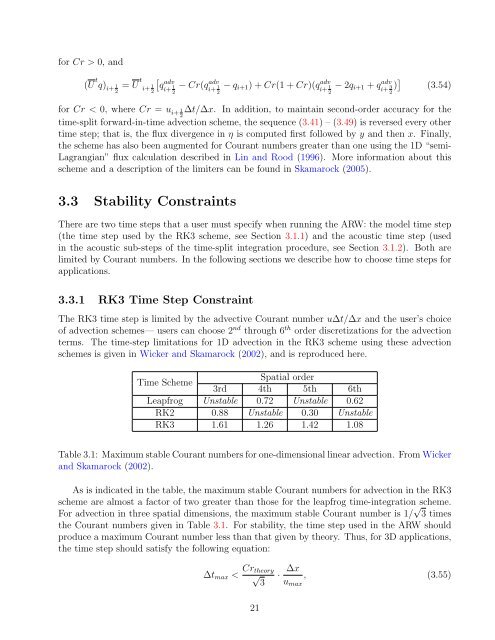Advanced Research WRF (ARW) Technical Note - MMM - University ...
Advanced Research WRF (ARW) Technical Note - MMM - University ...
Advanced Research WRF (ARW) Technical Note - MMM - University ...
Create successful ePaper yourself
Turn your PDF publications into a flip-book with our unique Google optimized e-Paper software.
for Cr > 0, and<br />
(U t q) i+ 1<br />
2<br />
= U t<br />
i+ 1<br />
2<br />
q adv<br />
i+ 1<br />
2<br />
− Cr(q adv<br />
i+ 1<br />
2<br />
− qi+1) + Cr(1 + Cr)(q adv<br />
i+ 1<br />
2<br />
− 2qi+1 + q adv<br />
i+ 3<br />
2<br />
) <br />
(3.54)<br />
for Cr < 0, where Cr = u 1<br />
i+ ∆t/∆x. In addition, to maintain second-order accuracy for the<br />
2<br />
time-split forward-in-time advection scheme, the sequence (3.41) – (3.49) is reversed every other<br />
time step; that is, the flux divergence in η is computed first followed by y and then x. Finally,<br />
the scheme has also been augmented for Courant numbers greater than one using the 1D “semi-<br />
Lagrangian” flux calculation described in Lin and Rood (1996). More information about this<br />
scheme and a description of the limiters can be found in Skamarock (2005).<br />
3.3 Stability Constraints<br />
There are two time steps that a user must specify when running the <strong>ARW</strong>: the model time step<br />
(the time step used by the RK3 scheme, see Section 3.1.1) and the acoustic time step (used<br />
in the acoustic sub-steps of the time-split integration procedure, see Section 3.1.2). Both are<br />
limited by Courant numbers. In the following sections we describe how to choose time steps for<br />
applications.<br />
3.3.1 RK3 Time Step Constraint<br />
The RK3 time step is limited by the advective Courant number u∆t/∆x and the user’s choice<br />
of advection schemes— users can choose 2 nd through 6 th order discretizations for the advection<br />
terms. The time-step limitations for 1D advection in the RK3 scheme using these advection<br />
schemes is given in Wicker and Skamarock (2002), and is reproduced here.<br />
Time Scheme<br />
3rd<br />
Spatial order<br />
4th 5th 6th<br />
Leapfrog Unstable 0.72 Unstable 0.62<br />
RK2 0.88 Unstable 0.30 Unstable<br />
RK3 1.61 1.26 1.42 1.08<br />
Table 3.1: Maximum stable Courant numbers for one-dimensional linear advection. From Wicker<br />
and Skamarock (2002).<br />
As is indicated in the table, the maximum stable Courant numbers for advection in the RK3<br />
scheme are almost a factor of two greater than those for the leapfrog time-integration scheme.<br />
For advection in three spatial dimensions, the maximum stable Courant number is 1/ √ 3 times<br />
the Courant numbers given in Table 3.1. For stability, the time step used in the <strong>ARW</strong> should<br />
produce a maximum Courant number less than that given by theory. Thus, for 3D applications,<br />
the time step should satisfy the following equation:<br />
∆tmax < Crtheory<br />
√<br />
3<br />
21<br />
· ∆x<br />
, (3.55)<br />
umax
















